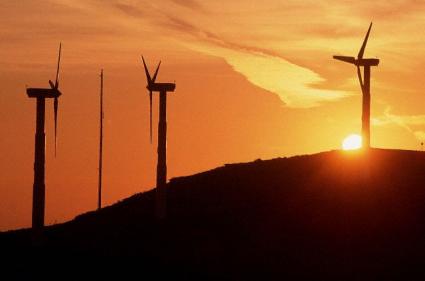Countering a group of anti-wind activists gathered at the State House today, Vermont’s largest environmental and consumer advocacy group made clear that responsible development of our state’s renewable wind resources, both large and small, is an essential part of our clean energy future.
“Turning wind into electricity is simply one of the most environmentally responsible ways to generate power that exists today,” said Paul Burns, executive director of the Vermont Public Interest Research Group (VPIRG). “Vermonters want to take control of their energy future by generating the power they need locally and in the cleanest way possible. That’s why it’s critical for us to maximize conservation and efficiency programs while developing clean, renewable energy sources like wind and solar now.”
VPIRG has a 40 year track record of fighting for clean energy. That record includes supporting the establishment of Efficiency Vermont, and leading efforts to expand its budget and purview over the years. VPIRG has been a leader in developing numerous state policies and programs to support local renewable power as well. And during 2011, VPIRG’s Solar Communities organizing program made it possible for more than 275 families in the state go solar in an easy and affordable way.
While promoting clean energy solutions for Vermont, VPIRG has also worked to oppose projects that have presented a real threat to Vermonters’ health and environment, including the Vermont Yankee plant in Vernon, the short-lived Vicon incinerator in Rutland, a plan to burns tires at the International Paper plant in Ticonderoga, NY and, most recently, the possibility of fracking for natural gas in Vermont.
“The real question for Vermont is not whether or not we should have wind power, it’s what kind of legacy do we want to leave future generations,” said Burns. “Will we step up and take responsibility by building clean energy here, or will we rely on dirty and dangerous power sources or force others to suffer the consequences of our energy use?”
A vast majority of Vermonters are willing to take responsibility by supporting clean energy development here, according to the Douglas administration’s Department of Public Service. In fact, 90% of Vermonters questioned supported a wind farm being built if it was visible from their backyard and 74% of those questioned strongly supported such a project.
But there are some Vermonters who obviously oppose wind power, just as there are those who oppose solar panels and clothes lines. Some suggest that we need only rely on small scale renewable for our power. Consider these facts:
One Wind Turbine at Lowell Will Produce Power Equal To:
- 1,528 residential 5 kW solar installation
- 1,003 solar trackers
- 828 residential 10 kW turbines
- 62 community 100 kW turbines
Power To Be Generated By Vermont’s Five Permitted Wind Farms Equals:
- 76,154 residential 5 kW solar installations
- 50,002 5.5 kW solar trackers
- 41,250 residential 10 kW turbines
- 3,094 community 100 kW turbines
VPIRG supports a plan to generate at least 25% of Vermont’s electricity needs from in-state wind power by 2025. This would require an additional 380 MW of installed capacity or 126 more 3MW turbines at 33% capacity factor in the state (beyond those projects already permitted). To provide the same amount of energy from community scale 100 kW turbines would require approximately 7,855 new installations. To provide that power from residential 10 kW wind turbines would require approximately 104,740 turbines. And to get it from typical residential solar installations would take 193,500 rooftops.
Other wind opponents suggest that wind power causes significant harm to human health. However, the scientific evidence suggests otherwise. A comprehensive and independent analysis just released by the Massachusetts Department of Environmental Protection, in collaboration with the Massachusetts Department of Public Health, found “no evidence for a set of health effects, from exposure to wind turbines that could be characterized as a ‘Wind Turbine Syndrome’.”
Still other wind opponents charge that wind power in Vermont cannot solve climate change. While that is not a debatable point, it does not mean that Vermonter have no obligation to do their part.
“No one in the world expects Vermont to solve climate change,” said Burns. “But if we are unwilling to do our part, indeed if we are unwilling to lead the way, just who are we counting on to solve it,” he asked.
“Wind power in Vermont is going to be part of a clean and healthy mix of energy sources we rely on moving forward,” Burns concluded. “From an environmental, public health and economic standpoint, it’s the responsible thing to do.”

